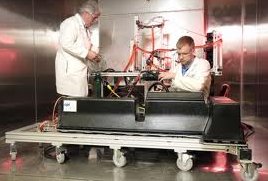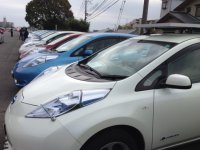Stakeholders striving to bring green transportation to the mainstream tend to articulate one, two, or all three of the following reasons for supporting their missions:
1. Petroleum: Reducing and eventually eliminating America’s (and Planet Earth’s) addiction to oil and all its negative implications on geopolitics and energy security, economic stability, and environmental issues.
2. Economics: A seismic shift has been in the works for years, long before the Great Recession, with globalization and adoption of new technologies driving change. As America sees several industries and jobs diminish or disappear, looking for new opportunities is a very good thing. Alternative fuels and vehicles offer the possibility of return on investments, OEM and infrastructure sales, good paying jobs, and sales tax revenue.
3. Emissions: On the regulatory front, along with sustainability policies being adopted by several corporations, green transportation tends to be primarily pushed forward to reduce tailpipe and carbon emissions. Air pollution and its health-hazard implications are there on the tailpipe smog side of the analysis, and for many organizations, climate change is the central issue.
I’ve recently heard persuasive arguments made that climate change is certainly occurring, but there’s very little humans can do about it. While reducing fossil fuel consumption and emissions is the clear path to reducing CO2 levels, it will only address one end of the scale; there are environmental forces – including what’s happening deep within our oceans – that are outside human-caused climate change and there’s very little we can do about it.
Whether these arguments have weight or not, it’s very important to stay current on what’s happening out there, as it will affect government and corporate transportation policies. So here’s the latest on the climate change debate….
The US Department of Commerce’s National Oceanic and Atmospheric Administration (NOAA) just released a report stating that the scorching hot heat that hit the north central and northeast US during the summer of 2012 was impacted by man-made climate change. The report’s analyses found evidence of human-caused climate change in half of the 12 extreme weather and climate events analyzed from last year. It started with unusual warmth in the spring season of 2012. “Approximately 35 percent of the extreme warmth experienced in the eastern U.S. between March and May 2012 can be attributed to human-induced climate change,” NOAA said about one study in the report. From another study in the report, NOAA stated, “High temperatures, such as those experienced in the [north central and northeast] U.S. in [summer] 2012 are now likely to occur four times as frequently due to human-induced climate change.”
The California Air Resources Board has a legal battle to deal with that’s attempting to undercut the Low Carbon Fuel Standard Program, which came out of AB 32 when it was enacted in 2006. Oil and ethanol companies want to void the rule and claim that the fuel standard discriminates against crude oil and biofuels producers outside California. There are two lawsuits in the works. CARB lost the federal court case and is waiting to find out if the Ninth US Circuit Court of Appeals will hear the case. Ethanol producer Poet LLC has another case filed with the state court claiming CARB violated the California Environmental Quality Act (CEQA) when it adopted the standard. Poet claims the rule unfairly penalizes ethanol producers by counting their indirect carbon emissions.
National Geographic’s September cover story, “Rising Seas,” shows the Statue of Liberty waist high in seawater. The lead feature article starts out with three statistics – 136 large coastal cities are now at risk from sea-level rise; 40 million people are at risk in those cities; and there’s $3 trillion value of assets at risk. A fold-out map shows what the planet would look like if all the ice caps melted – the southeast US is underwater; California doesn’t break off and sink to the bottom of the ocean, but somehow its central agricultural region becomes a giant lake. The global map forecasts 5,000 years into the future when the sea level rises 216 feet, perhaps much faster if we add five trillion more tons of carbon to the atmosphere. The average earth temperature will be shooting up from the current 58 degrees Fahrenheit to 80 degrees. Most of magazine’s special section focuses on tactics for surviving flooding and other consequences that come out of disasters like last year’s Hurricane Sandy. In June, Mayor Michael Bloomberg outlined a $19.5 billion plan to defend New York City against rising seas. Tim Folger, author of the article does mention the role of human decisions impacting melting ice caps…. “Unless we change course dramatically in the coming years, our carbon emissions will create a world utterly different in its very geography from the one in which our species evolved,” Folger wrote in the summary. “No matter how much we reduce our greenhouse gas emissions, Foster (Gavin Foster, a geochemist at the University of Southampton in England) says we’re already locked in to at least several feet of sea-level rise, and perhaps several dozens of feet, as the planet slowly adjusts to the amount of carbon that’s in the atmosphere already.”
In June of this year, President Barack Obama came back to the issue of climate change, which he’d basically avoided during his reelection campaign last year. In June of this year, the White House published the “Climate Action Plan” and the president gave a speech that month on climate and energy. The theme of the transportation portion of the report digs into increasing fuel economy standards and developing and deploying advanced transportation technologies as the way to address climate change. The report does start out with a quote from the president’s reelection inaugural speech in January where he mentioned the overwhelming majority of scientists convinced that climate change is for real ….. “We will respond to the threat of climate change, knowing that the failure to do so would betray our children and future generations. Some may still deny the overwhelming judgment of science, but none can avoid the devastating impact of raging fires and crippling drought and more powerful storms,” he said. Our moral obligation is to hand over sustainable energy sources to future generations, according to the president. Obama addressed the topic during the G20 summit, though the issue of what to do about Syria was much more important. Five Scandinavian nations (Denmark, Finland, Iceland, Norway, and Sweden) agreed with the president on the goals outlined in the Climate Action Plan.
Transportation produced 31% of total carbon emissions and 26% of greenhouse gas emissions (GHG) in the US during 2011, according to the US Environmental Protection Agency. Electricity, industry, residential and commercial, and other non-fossil combustion make up the rest of carbon dioxide (CO2) emissions in the EPA analysis. GHG and CO2 emissions go through ebbs and flows of interest and action by government entities, researchers, and businesses. The published B2B and consumer surveys make the issues look vulnerable to fluctuation on priority lists for elections, investments, purchase decisions, and lifestyle concerns. Climate change is not going away as a pressing issue – especially in the wake of natural disasters and weather catastrophes – but it’s probably best suited for success in league with petroleum and economic issues.





